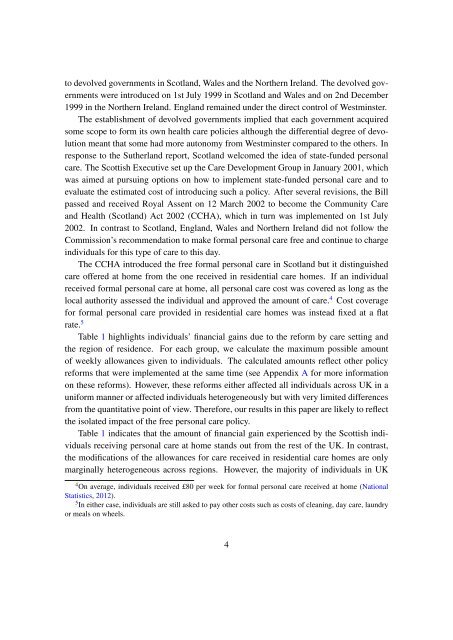dressing individuals
17&r=age
17&r=age
- No tags were found...
You also want an ePaper? Increase the reach of your titles
YUMPU automatically turns print PDFs into web optimized ePapers that Google loves.
to devolved governments in Scotland, Wales and the Northern Ireland. The devolved governmentswere introduced on 1st July 1999 in Scotland and Wales and on 2nd December1999 in the Northern Ireland. England remained under the direct control of Westminster.The establishment of devolved governments implied that each government acquiredsome scope to form its own health care policies although the differential degree of devolutionmeant that some had more autonomy from Westminster compared to the others. Inresponse to the Sutherland report, Scotland welcomed the idea of state-funded personalcare. The Scottish Executive set up the Care Development Group in January 2001, whichwas aimed at pursuing options on how to implement state-funded personal care and toevaluate the estimated cost of introducing such a policy. After several revisions, the Billpassed and received Royal Assent on 12 March 2002 to become the Community Careand Health (Scotland) Act 2002 (CCHA), which in turn was implemented on 1st July2002. In contrast to Scotland, England, Wales and Northern Ireland did not follow theCommission’s recommendation to make formal personal care free and continue to charge<strong>individuals</strong> for this type of care to this day.The CCHA introduced the free formal personal care in Scotland but it distinguishedcare offered at home from the one received in residential care homes. If an individualreceived formal personal care at home, all personal care cost was covered as long as thelocal authority assessed the individual and approved the amount of care. 4 Cost coveragefor formal personal care provided in residential care homes was instead fixed at a flatrate. 5 Table 1 highlights <strong>individuals</strong>’ financial gains due to the reform by care setting andthe region of residence. For each group, we calculate the maximum possible amountof weekly allowances given to <strong>individuals</strong>. The calculated amounts reflect other policyreforms that were implemented at the same time (see Appendix A for more informationon these reforms). However, these reforms either affected all <strong>individuals</strong> across UK in auniform manner or affected <strong>individuals</strong> heterogeneously but with very limited differencesfrom the quantitative point of view. Therefore, our results in this paper are likely to reflectthe isolated impact of the free personal care policy.Table 1 indicates that the amount of financial gain experienced by the Scottish <strong>individuals</strong>receiving personal care at home stands out from the rest of the UK. In contrast,the modifications of the allowances for care received in residential care homes are onlymarginally heterogeneous across regions. However, the majority of <strong>individuals</strong> in UK4 On average, <strong>individuals</strong> received £80 per week for formal personal care received at home (NationalStatistics, 2012).5 In either case, <strong>individuals</strong> are still asked to pay other costs such as costs of cleaning, day care, laundryor meals on wheels.4




